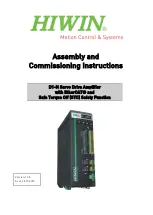
9
8
The extra gain of the EF86 allows the power amplifier to be driven harder for more
compression and rich harmonic distortion. The EF86 also adds its own particular
compression and distortion flavour to this channel.
Channel 2 – The ECC83 Channel
Hi/Lo inputs provide perfect matching either directly to the guitar (high sensitivity) or
for connection to higher output effects pedals (low sensitivity).
This channel’s tone is most easily described as a blend between a boutique EL84
combo and classic British 100W head. The philosophy is to deliver the bell-like ring
and richness of a warm, retro combo with the added openness and roar of a vintage
high wattage head.
The flexibility of this channel is further enhanced by the addition of the 2-position
Voice switch which completely reconfigures the tone shaping network to give either
a ‘Warm’ or ‘Bright’ response.
Transformers
All Artisan transformers are traditionally made from the highest grade materials to
Blackstar’s demanding sonic and reliability specifications.
Output Transformers
The design of the output transformers is critical to ensuring highly responsive feel
and a full natural frequency response.
All the Artisan output transformers are constructed using laminations made of
the highest grade, grain oriented steel. This minimises core losses and ensures
optimum fidelity and dynamics.
Mains Transformer
The Artisan mains transformers are also constructed using laminations made of the
highest grade, grain oriented steel. This minimises stray magnetic fields which can
be a source of unwanted noise and hum.
English
English
Front Panel
Channel 1
1. Hi Input
This is the high sensitivity input of Channel 1. This input has 6dB more (i.e. twice
as much) gain as the Lo Input. Use this input if you wish to achieve power amplifier
break-up and overdrive. Always use a high quality screened guitar lead.
2. Lo Input
This is the low sensitivity input of Channel 1. This input has 6dB less (i.e. half as
much) gain as the Hi Input. Use this input if you wish the power amplifier to remain
clean (this is especially useful if the guitar used has high output pick-ups). Always
use a high quality screened guitar lead.
3. Volume
This controls the volume of Channel 1. Turning it clockwise increases the volume.
The EF86 used in Channel 1 provides higher levels of gain and distortion than the
ECC83 in Channel 2 and its own unique compression characteristics. This channel
will sing with sustain and give you all the drive you need for classic bluesy lead
tones. Remember that you can use the Lo Input of Channel 1 to experiment with
the clean side of the EF86’s tonal character.
4. Tone
This passive control affects the tonal characteristics of Channel 1. Fully counter-
clockwise the tone is thick and dark, turning it clockwise increases the amount of
treble and the tone becomes more shimmering and bright.
5. Bass Shape
This 5-position switch controls the bass drive into the power amplifier and enables
the user to quickly and easily select from a wide palette of tonal options, from bright
and glassy through to fat and smooth. In position 1 the tone is sharp with a tight,
funky bottom end. In position 2 the tone is firm with lower mids. In position 3 the
tone achieves a more even balance across the mid range and bass. In position 4
the tone becomes richer and deeper. Position 5 offers the warmest, fullest tone of
the five positions.
Channel 2
6. Hi Input
This is the high sensitivity input of Channel 2. This input has 6dB more (i.e. twice as
much) gain as the Lo Input. Always use a high quality screened guitar lead. Use this
input if you wish to achieve power amplifier break-up and overdrive.
7. Lo Input
This is the low sensitivity input of Channel 2. This input has 6dB less (i.e. half as
much) gain as the Lo Input. Always use a high quality screened guitar lead. Use this
input if you wish the power amplifier to remain clean. This input is especially useful
if the guitar used has high output pick-ups.





































